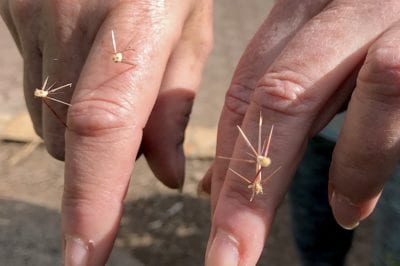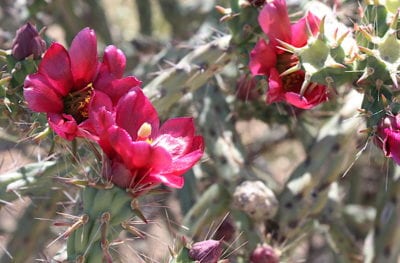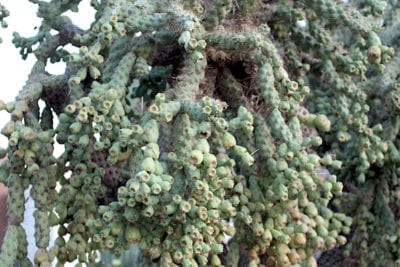
See the Sneaky Cholla That Got Me and More
Cholla ("choy-ah") cactus: Love it or hate it? Here I give good reasons for both. I'm curious what you think and if you've had experiences with cholla too. Do LMK in the comments!
It bit me in Baja
In Baja California recently I was showing off my knowledge of native succulents when one "got" me. The friend who was taking a video with my phone gasped when I unsuccessfully tried to set a 3-inch-long chunk of cholla ("choy-ah") cactus back onto a boulder. It resolutely clung to my fingers.

Cholla spines have tiny, fish-hook barbs.
When I tried to shake it off, the cholla hopped into a more secure position. Next I tried to remove it with my other hand, and spines stuck to that one too. Wow, what a determined little cactus!

I had help removing these cholla spines. Watch the 20-second tweezered extraction.
Cylindropuntia, of which there are 30+ species, are sometimes referred to as "jumping chollas" or "horse cripplers." Like many other succulents, chollas reproduce via both seeds and cuttings. Cylindrical joints detach readily from the mother plant and cling with astonishing tenacity to whomever or whatever brushed them. They take root where they fall off, usually far enough from the original plant so they're not competing with it for water, sun or nutrients.

A cholla (cylindropuntia) with beautifully backlit orange spines
They love it in Tucson
My Mexico experience reminded me of when I addressed the Tucson Cactus & Succulent Society, where I made the mistake of saying I don't recommend that anyone grow cholla. "Could there be a more unfriendly plant?" I asked the group. Well, you'd think I'd insulted the entire state of Arizona.

Arizona residential architecture and gardens are distinctive. Textures and colors blend to create lovely desert landscapes appropriate to the region.
"There are more than a dozen different species," members told me, each more eager than the last to extol the virtues of cylindropuntias. "Cholla is beautiful."

Cholla flowers come in all warm colors.
"This is my cholla comb," one told me, pulling a small comb from his shirt pocket. "If I get spines in my clothing or skin, I just comb them out."

A mourning dove nests in Cylindropuntia fulgida at the Arizona-Sonora Desert Museum near Tucson.
"Cholla is an important part of the desert ecology," said another. "Nesting birds feel safe in it. Snakes, coyotes and other predators can't get to them or their young." Birds aren't alone in using cholla as a security enhancement, she added. "I have it below my bedroom window to keep burglars out."

At Tohona Chul botanic garden near Tucson.
My cholla hunt at Tohona Chul
Intrigued, I went on a cholla hunt. I found this orange-flowered one at Tohona Chul botanic garden near Tucson. Not bad looking, considering it survives broiling desert heat and temperatures below freezing, with no water for months.

Cylindropuntia versicolor

Cylindropuntia versicolor flowers
Cholla comes in more colors than I'd assumed---not just its flowers, but even its spines and skin. The specimen of Cylindropuntia versicolor above has green, rose-red and maroon segments, and translucent, rust-red flowers.

Cylindropuntia bigelovii (teddy bear cactus)
Cylindropuntia bigelovii is commonly called teddy bear cholla. Look how fuzzy it is, and its cute little ears. Like all chollas---like most spiny cacti, for that matter---it's beautiful backlit.

Cylindropuntia bigelovii flowers
The flower petals of teddy bear cholla are buttery yellow tipped in rose-red.

Cylindropuntia spinosoir
Cylindropuntia spinosoir, illuminated by late afternoon sun in a Tucson suburb, glows pink.

Cylindropuntia fulgida var. mammillata (chain fruit cholla)
Chain fruit cholla forms ropy, pendant strands. Doesn't this one look like a face?

Cylindropuntia ramossisimus (diamond cholla)
Cylindropuntia ramosissima, aka diamond cholla, has pencil-thin stems lined with glittering, translucent toothpicks.

I pretended to hug Cylindropuntia fulgida, then sent this photo to my new friends at the Tucson Cactus & Succulent Society.
Why do the spines stick?
As for my Mexico adventure, what was it about those spines that made them stick? Like those of all cacti, cholla spines are modified leaves. But cholla spines differ in that they have papery sheaths lined with microscopic barbs. Try to pull one from your skin, and you'll discover it's well anchored. Sure it'll come out, but if a bit of barb remains, you'll feel it whenever pressure is applied to the area. If that's just too annoying, you may have to dig it out with a needle.
"Living and working around cactus is an art that requires the balance of a dancer, the strength of a weight lifter and a high tolerance for pain," one of my favorite authors, Maureen Gilmer, wrote in the Desert Sun. "In time we become immune to the arrows of these New World beauties, and in all our homes are the tools of the trade. These are the magnifying glass, sharp needles and tweezers with a bit of Neosporin afterwards if the going gets bloody."
Fortunately, "my" cholla's spines were shallowly embeded. The only thing that hurt afterwards was my pride.
Related Info on this site
Cactus: Details, Photos and Varieties
Cactus Care, Gallery and Names All cacti are succulents, but not all succulents are cacti. They’re not for everyone, but once hooked (forgive the pun) you’ll collect more and more. See All Succulent Types Aeonium Agaves Aloes Cactus Crassula Echeveria Euphorbias Ice Plants Kalanchoe Portulacaria Senecio About Cacti Native to deserts and dry regions of…


Nice article
Am researching types of cholla, especially from Baja
Cylindropuntia bigelovii (Teddy bear cholla) Is the best for me. I love it 😻
VERY DANGEROUS, if they attack you. My husband was intense pain;; had to call 911. Then I was attacked trying to help him. My right leg is still
Black and blue. DO NOT RECOMMEND
Good to know, Anne. Thanks for the all-caps warning. Thing is, most people are already wary of cholla, but somehow it gets them anyway. Sneaky plant.
I have a cholla. I noticed that in the center of the spines on the fruits is a clear drop of honeydew like substance. I did not notice any insects. At first I suspected this was honeydew from a sucking insect but have seen any. Any idea what this might be?
Hi Mickey — Do you think it might just be juice from the fruit?
The product of extra-floral nectaries. Common in chollas and prickly pear. They secrete a nectar which usually attracts ants, which protect the new fruit or growth by defending the new food source.
Thank you, Mickey!
I love my Cholla cacti….I am growing them in Georgia, north of Atlanta. They are so hardy and have fantastic blooms…but unfortunately attack me on occasion. One time I got 5 thorns in my knuckle and didn’t remove them immediately(maybe 60 seconds later) so the whole had swelled up and needed steroids to fix the problem. I still love them!!! I am always looking for more varieties to help move to Georgia.
Cholla in Georgia?! Wow, I had no idea they’d grow there. Thanks for telling me. Oh, Ken, you’re such a guy. Forgive me for a momentary indulgence in stereotypes: I’ve observed that men tend to love cholla and will put up with their mean streak, while women (me included) regard them with a wariness similar to that allocated to reptiles. But there are always exceptions, of course; I’m thrilled when I see a “good” snake in my garden (a varmint-eater!) and I like to LOOK at cholla, especially in bloom. — DLB